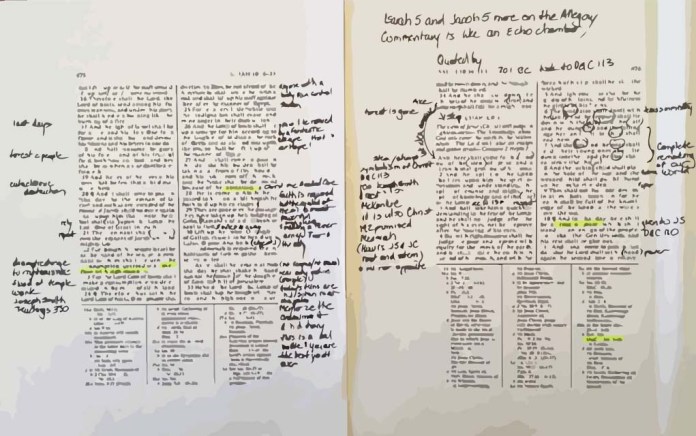Ken Krogue: Let’s talk about…again, one of the things I do…my background is social and digital media, and I want to make Isaiah cool.
Shon Hopkin: Yeah.
Ken Krogue: I want to get it out there, and we did a survey recently and it’s the top read book of the Old Testament, it’s the top quoted book. It comes from the Old Testament, but it’s the one that seems to be the most difficult for people to get their head around.
Shon Hopkin: Sure.
Ken Krogue: Why do you think that is?
Shon Hopkin: So, besides the book of Genesis, you pick just about anywhere in the Old Testament, and we are…these are still human beings and children of God, like we are, but we are foreigners in a foreign land, trying to understand the way they saw the world and the way they talked, and the way they thought. Now, the prophets, that being said, the prophets have a deeply profound understanding of who God is, of what His identity or His attributes are. And so, it’s not like their understanding is old or outdated. That’s not the case. I would say that I’ve learned more about who God is from Isaiah, and from Joseph Smith, than from any other place, right.
Ken Krogue: Wow, that’s a profound statement.
Shon Hopkin: I was just talking about it in class yesterday. We read this from Isaiah 16, it’s a prophecy against Moab, and there’s this beautiful moment that we dug into it a little bit and said, look, what he understands about God’s nature, and it was revelatory I think to many of us in the room, to just see God in ways that felt appropriate and inspiring and edifying, but that maybe we hadn’t considered before, and I just think it helps us then approach Him more powerfully, more effectively. So, yeah, but it is a foreign way of talking, it’s a foreign culture, and then I would say the other challenge is also the blessing of Isaiah, and that is that once you start digging in as people of the house of Israel, we want to see ourselves in Isaiah, which is absolutely what we’re supposed to do, but we’re going to read Isaiah a little bit differently than Nephi read.
Ken Krogue: The whole concept…
Shon Hopkin: Absolutely, yes, yes. And so, typically what we’ve done historically, is we’ve just jumped straight to us, just sort of said, look here we are and who exactly are we seeing. And that’s not wrong, but Nephi also saw us, but he said the reason I can liken Isaiah to my situation is because Isaiah talks about all of the house of Israel, and he talks about the Gentiles, so we’re a branch of the house of Israel, so his words can be applied to our situation. That’s one of the things that I try to do in my classes, and I think others try to do and what we try do with this harmony, is start from…if Isaiah is a prophet in his own time, his words have to have meaning to them. They can’t just be gibberish intended for two thousand years from now.
Ken Krogue: Yes.
Shon Hopkin: That’s not how prophets talks. President Monson and President Nelson, they’re not talking just to people a hundred years from now. They’re talking to us, for our needs today, and there’s also prophesy of the future. And so, we said, well what was Isaiah doing and then once you see that, then all of a sudden you can do what Nephi trained us to do, and that is liken it to us, and it becomes very powerful.
Ken Krogue: Yes.
Shon Hopkin: And I don’t want to talk too much, but I can give a couple of examples, if you would like.
Ken Krogue: Please.
Shon Hopkin: So, Elder Holland just talked about the famous Messianic prophecy, a virgin shall give birth.
Ken Krogue: Yes.
Shon Hopkin: And he sees that, as do I, as a duly fulfilled prophecy. It’s been fulfilled most powerfully in the birth of Christ, but that had to have a meaning for Ahaz in Isaiah’s day, right. And so, there is a woman, an almah, in Hebrew a young maiden probably, possibly Isaiah’s wife even. The very next chapter talks about her giving birth. That is going to give birth to a child and Ahaz is terrified of all of the threats in his day, but look Ahaz, this woman will have faith in God, and continue to have children, we’ve got a family, we’re going to trust in God. God is with us, and these threats that you think are going to destroy everything, if you don’t cater to them, they’re going to blow away like smoke, right?
Ken Krogue: Yes.
Shon Hopkin: So, and in the very next chapter, it talks about Isaiah’s wife actually having a child, interestingly enough.
Ken Krogue: Which chapter was this again?
Shon Hopkin: This is Isaiah 7, and then Isaiah 8 goes onto talk about Isaiah’s wife having a child. Well at any rate, so then…and Elder Holland talks about this, and there’s a tradition that Isaiah’s wife is even of the royal lineage.
Ken Krogue: Oh wow.
Shon Hopkin: And so, then that makes him more powerful because she is of this line of David potentially, and it just points beautifully to a future young maiden, a virgin Mary, who is going to exercise her faith in God, in the midst of great threats and God will be with us. Emmanuel, God with us.
Ken Krogue: Yes, wow. Which as the whole, handles Messiah?
Shon Hopkin: Yes, indeed, that’s one of the phrases we’re most familiar with in Isaiah. So, that’s fine and good, dual fulfilment, but then once we’ve started with the historical context, now watch what can happen as we come to the modern day and here we are also of the house of Israel surrounded by threats, all kinds of threats of war, and danger, and how do you raise a family in this environment and we can’t do it, and people are really struggling with anxiety and even terror about their future in this very difficult world and Isaiah’s message to us, like it was to Ahaz, is, it’s going to blow away. It’s smoke that’s going to blow away, you have trust in God, continue to have children. A young woman, and throughout the Church, right, there are young maidens so to speak or whatever age they are right, who are willing to continue to have families and exercise their faith in the Lord, and the house of Israel will continue in steadiness to trust in the Lord and let the threats of the world go by. And we can do it even more powerfully because the young woman, Mary, did bring forth Christ, who then has made all things efficacious as we have faith in God. And so, you sort of have Christ as the center moment, but being of the house of Israel, all of a sudden, this prophecy, if you understand the historical context, means so much more for me today. Yes, it testifies of Christ, but because of Christ, I can do what Ahaz did not, I can move forward with faith.
 David Ridges, LDS scholar, and longtime Seminary and Institute teacher suggests three things to get into the Book of Isaiah. These include:
David Ridges, LDS scholar, and longtime Seminary and Institute teacher suggests three things to get into the Book of Isaiah. These include:






















 If you’d like, split the printing into two or more sections and bind separately (especially with the Old Testament) for easier writing. Alternatively, you can three-hole-punch them and put them in a binder, but that just doesn’t look as cool. I printed my own copy at home, but I had mine bound at the UPS store for somewhere around $5, with a stiff cover for the front and back to protect the pages. The nice thing about these is that you can do whatever you want with them! If you find some creative use, just come back and
If you’d like, split the printing into two or more sections and bind separately (especially with the Old Testament) for easier writing. Alternatively, you can three-hole-punch them and put them in a binder, but that just doesn’t look as cool. I printed my own copy at home, but I had mine bound at the UPS store for somewhere around $5, with a stiff cover for the front and back to protect the pages. The nice thing about these is that you can do whatever you want with them! If you find some creative use, just come back and 

